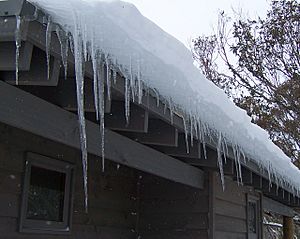Icicle facts for kids
Icicles are formed on days when the outdoor air temperature is sub freezing and heat from sunlight melts snow or ice on anything sloped. The droplets of water freeze as they loses their heat to the cold air, forming a cone-like shape of ice.
Contents
Shape
Once water starts dripping, it begins to freeze into a certain side. It will melt and freeze over and begin to create icicles. As winter gets longer and temperatures stay in the freezing and sunlight is present, water will just melt and drip alongside the icicle causing them to get longer and sharper. The reason why icicles are pointy is because the water drips in a downward motion. Icicles can range from millimeters to feet in length.
Snow
Once temperatures reach 32 degrees Fahrenheit (0 degrees Celsius), snow starts to fall. Snow will begin to build on top of each snowflake and sit on whatever surface is present. Snow is white in color and can be from the width of a single strand or hair to even inches long. Although it must be cold in order for snow to fall, it is not frozen rain, but it is a cluster of many crystals falling from the clouds.
Accidents
Icicles are beautiful, but they can be very dangerous. Icicles have been reported fatal since the 1700's, from falling on people and causing accidents to property being reported. Icicles can cause damage on many structures such as buildings and homes, once ice forms layers the weight of it can cause the structure to fall or break off. Icicles can also be formed on bridges over streets and highways creating a potential danger for nearby motor vehicles passing by.
Images for kids
-
Icicles gathered on a street sign in Eugene, Oregon
See also
 In Spanish: Carámbano para niños
In Spanish: Carámbano para niños





